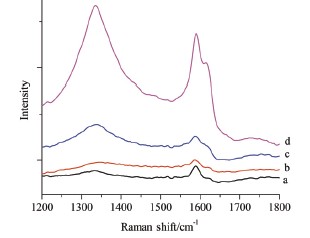[1] Lacerda, L.; Raffa, S.; Prato, M.; Bianco, A.; Kostarelos, K. Nano Today 2007, 2, 38.
[2] Wang, J.; Cui, R.; Liu, Y.; Zhou, W.; Jin, Z.; Li, Y. J. Phys. Chem. C 2009, 113, 5075.
[3] Dresselhaus, M. S.; Dresselhaus, G.; Saito, R.; Jorio, A. Phys. Rep. 2005, 409, 47.
[4] Dresselhaus, M. S.; Dresselhaus, G.; Jorio, A.; Souza, A. G.; Saito, R. Carbon 2002, 40, 2043.
[5] Wang, X.; Wang, C.; Cheng, L.; Lee, S.-T.; Liu, Z. J. Am. Chem. Soc. 2012, 134, 7414.
[6] Kneipp, K.; Wang, Y.; Kneipp, H.; Perelman, L. T.; Itzkan, I.; Dasari, R. R.; Feld, M. S. Phys. Rev. Lett. 1997, 78, 1667.
[7] Chu, H. B.; Wang, J. Y.; Ding, L.; Yuan, D. N.; Zhang, Y.; Liu, J.; Li, Y. J. Am. Chem. Soc. 2009, 131, 14310.
[8] Chu, H. B.; Wei, L.; Cui, R. L.; Wang, J. Y.; Li, Y. Coord. Chem. Rev. 2010, 254, 1117.
[9] Chu, H. B.; Cui, R. L.; Wang, J. Y.; Yang, J. A.; Li, Y. Carbon 2011, 49, 1182.
[10] Zavaleta, C. L.; Smith, B. R.; Walton, I.; Doering, W.; Davis, G.; Shojaei, B.; Natan, M. J.; Gambhir, S. S. Proc. Natl. Acad. Sci. U. S. A. 2009, 106, 13511.
[11] Jorio, A.; Pimenta, M. A.; Filho, A. G. S.; Saito, R.; Dresselhaus, G.; Dresselhaus, M. S. New J. Phys. 2003, 5, 139.1~139.17.
[12] Pimenta, M. A.; Dresselhaus, G.; Dresselhaus, M. S.; Cancado, L. G.; Jorio, A.; Saito, R. PCCP 2007, 9, 1276.
[13] Zhao, W.; Brook, M. A.; Li, Y. ChemBioChem 2008, 9, 2363.
[14] Zheng, J.; Li, X.; Gu, R.; Lu, T. J. Phys. Chem. B 2003, 106, 1019.
[15] Zheng, J.; Zhou, Y.; Li, X.; Ji, Y.; Lu, T.; Gu, R. Langmuir 2003, 19, 632.
[16] Wang, Y.; Chen, H.; Dong, S.; Wang, E. J. Chem. Phys. 2006, 124, 074709.
[17] Kim, K.; Kim, K. L.; Shin, D.; Choi, J.-Y.; Shin, K. S. J. Phys. Chem. C 2012, 116, 4774.
[18] Zhang, J.; Li, X.; Sun, X.; Li, Y. J. Phys. Chem. B 2005, 109, 12544.
[19] Hildebrandt, P.; Stockburger, M. J. Phys. Chem. 1984, 88, 5935.
[20] Volny, M.; Sengupta, A.; Wilson, C. B.; Swanson, B. D.; Davis, E. J.; Turecek, F. Anal. Chem. 2007, 79, 4543.
[21] Datsyuk, V.; Kalyva, M.; Papagelis, K.; Parthenios, J.; Tasis, D.; Siokou, A.; Kallitsis, I.; Galiotis, C. Carbon 2008, 46, 833.
[22] Peng, Y.; Liu, H. W. Ind. Eng. Chem. Res. 2006, 45, 6483.
[23] Chiang, I. W.; Brinson, B. E.; Huang, A. Y.; Willis, P. A.; Bronikowski, M. J.; Margrave, J. L.; Smalley, R. E.; Hauge, R. H. J. Phys. Chem. B 2001, 105, 8297.
[24] Xiao, Y. H.; Ye, X. X.; He, L.; Che, J. F. Polym. Int. 2012, 61, 190.
[25] Cai, K. Y.; Yao, K. D.; Cui, Y. L.; Yang, Z. M.; Li, X. Q.; Xie, H. Q.; Qing, T. W.; Gao, L. B. Biomaterials 2002, 23, 1603.
[26] Kam, N. W. S.; O'Connell, M.; Wisdom, J. A.; Dai, H. J. Proc. Natl. Acad. Sci. U. S. A. 2005, 102, 11600.
[27] Jana, N. R.; Gearheart, L.; Murphy, C. J. Chem. Mater. 2001, 13, 2313.


